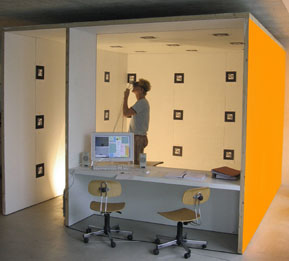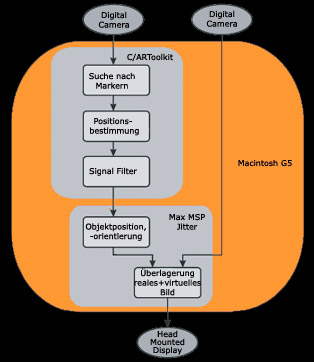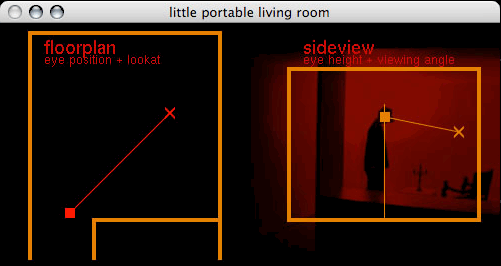OBJECTIVE
| SCENARIOS | TECHNOLOGY
| process | SOURCES
| TEAM
Technology
Installation
living-room augments a given room of
3.10 x 3.75 x 2.45 meters. This room is decorated with markers that enable
visual position tracking. The living-room book contains
the collection of different scenarios. Looking at the marker of a specific
scenario causes a scene change.

Hardware
living-room runs on an Apple G5 with 1.5 Gbyte RAM. Two
Fire-I unibrain FireWire cameras record the environment, one is needed
for position tracking and the other delivers the background image for
the AR scenery.

Software and Implementation
ARtoolkit is used for visual position tracking in the room and the recognition
of the scenario changes. The scenarios are implemented in Max/MSP and
Jitter. ARtoolkit was expanded with functions to adapt the position tracking
to the specific situation of living-room and to communicate
with Max/MSP over sockets and the OSC (Open Sound Control) protocol.
In Max/MSP/Jitter a special patch was developed, the living-room
engine, that contains the basic functionalities needed to run the different
scenarios, like the initialisation procedures, the rendering of the background
image, the socket connection to ARtoolkit, and the scene-change function.
Every scenario is a further patch that is loaded and unloaded by the living-room engine patch. In the individual scenario patches the geometry,
sound, and dynamic behaviour of each scene are defined.

Little Portable Living
Room
A special application was created to allow the development of scenarios
independently of the physical living-room. The interface enables the user
to change camera position and look-at point. The data is sent to Jitter
using the OpenSoundControl protocol in the same way as the ARToolkit component.

Living room wallpaper
After experimenting for a while with 9 markers on each wall (see topmost
image) it became obvious that we needed more markers and bigger ones;
more markers to solve the problem when no marker is visible because the
user is too close to a wall. The larger markers improve position determination,
when the user is far away from a recognized marker.
A script was written to generate “wallpaper”, since
it would be very tedious to mount every marker individually on the walls
of the physical living-room. The script, written in Perl, generates postscript
files, which can be plotted, and creates the marker configuration file,
with the position information needed by ARToolkit. Different parameters
can be set in the script, i.e. the size and number of markers and their
distances from the edges. Currently we have mounted 5 markers in height
and 6-7 along the length of the walls.

